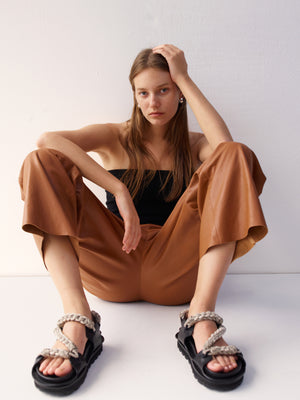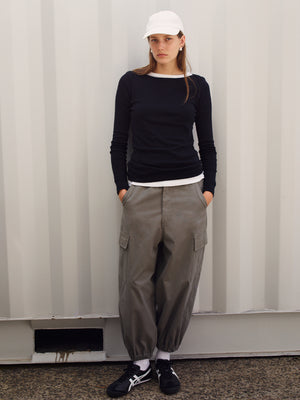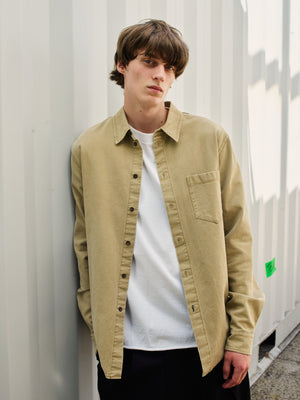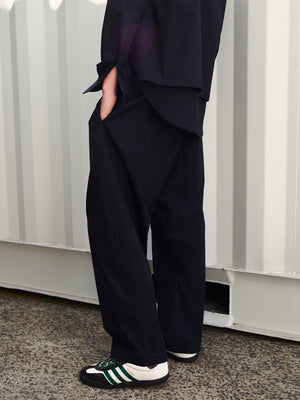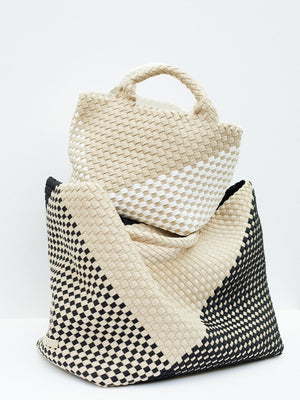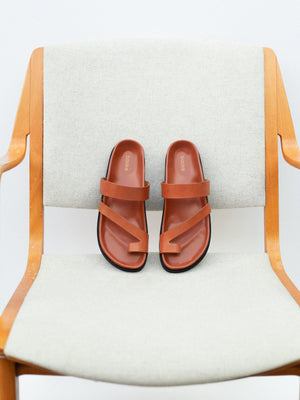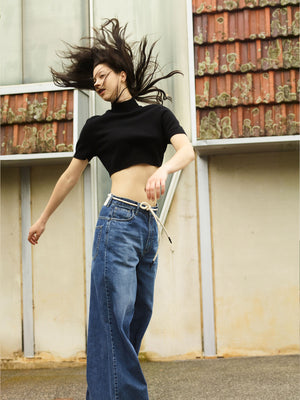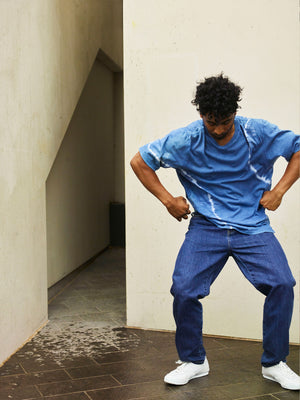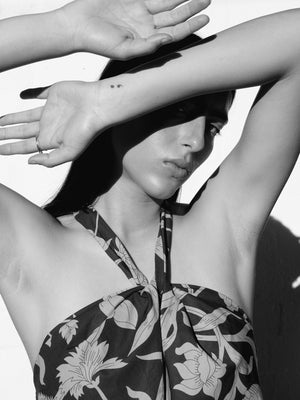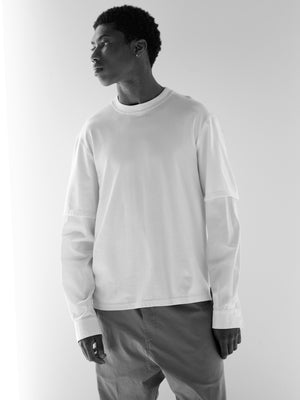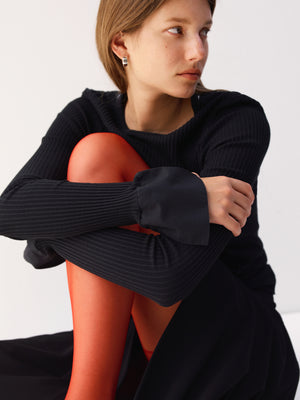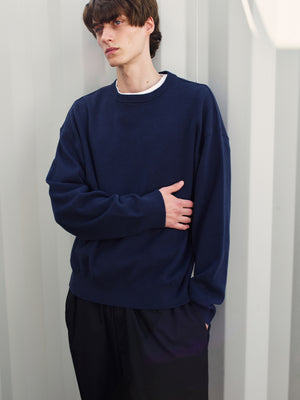Your Bag is Empty
at home with sam and arabella mcintosh
as we make peace with the new normal, friends of bassike, sam and arabella mcintosh share a glimpse into their world. a true multi-hyphenate, arabella balances interior decorating, styling, consulting, and being a mother. she chats with us about how she’s spending time in isolation, the principles behind her business, palm beach black, and her tips for choosing pieces for the home with longevity and purpose. founder of stab magazine, sam lets us in on the origins of his now global surf publication, how the team are working to support and inspire the community during this unprecedented time, and the words of wisdom he lives by.
now more than ever, the home is the most important space in our lives. how do you find joy in your surroundings during this difficult time, and how are you staying busy?
sam: i’m going to say something that won’t age well but i think we’ll remember this time fondly. when was the last time you didn’t have places to go, people to see? to properly engage has been nice.
arabella: like any family, the norm was rushing from one activity or commitment to another. the past few weeks, our lives have been stripped back and it’s opened up so much white space to be filled with simple yet really enjoyable activities like cooking and drawing with the kids. it was confronting at first, but now we have adjusted, it's really quite nice. we are bouncing between work, homeschool, trying to stimulate the kids with something other than television, cooking, eating and cleaning… and more cooking, eating and cleaning! i have gained a whole new appreciation for the school lunch box and the amount of time it saves me in the kitchen! I believe we are all recalibrating what is important in our lives. Just as mother nature is calibrating a few things for us too.
what does a typical day in your lives look like?
arabella: much like everyone else in this current climate - staring at the same four walls every day! we’re (trying to) stay sane by getting up before the kids for some much needed quiet time. then a quick swim or surf all together before sam heads off to work from a makeshift office in his parent’s pub (which is currently closed), and i tackle a few hours of homeschooling, in between work calls and emails. at some point i attempt a zoom yoga session with my favourite studio back in la, although i’m almost always interrupted by the kids. and then it suddenly seems time for a g&t.
what’s currently:
on your bookshelf?
vintage pottery, plants, art & surf books
commune; designed in ca by @communedesign
abode - thoughtful living with less by mitnik-miller & mason st. peter, @maraserene
surf shacks by @indoek
bastian woudt mukono
this is home by @nataliewalton
the shane gang by shane stedman @join_the_shane_gang
venice, ca: art and architecture in a maveric community by michael webb
on your tv screen?
ozark, after life.
playing on repeat?
texas sun by khruangbin/leon bridges & running red lights by the avalanches.
are there any local businesses that you are choosing to support during this challenging time?
arabella: i am trying to continue paying for subscriptions and services, particularly media we value that really need our support rather than cutting back. such as kcrw donations for the community radio we listen to in la, and online news such as the NY times and the guardian. i am doing online classes at my favourite yoga studio 'love yoga' at home in venice. sam is doing online training with @johnnygannon, @luke.steadman. i am also about to cut sam's hair under online guidance of a scissor master @kristenshawhair.
are there any diy projects you’ve been working on at home?
arabella: yes, so many. i am happiest when i am working on a project, i can’t relax, ever. we just finished painting all the gutters and trim and will start bagging the brick work next week.
with the kids, we always save cardboard and other materials for projects. we’ve made a marble run on the wall using old toilet paper rolls and magazines, and are planning on making a cardboard skatepark next week for bobby’s tech deks (mini skateboards). we’ve been making postcards to send to their grandparents in england and doing lots of baking. @napkinapocolypse is the queen of kids "trash craft" and she just posted a car wash made from cardboard and toilet paper rolls that looks like fun.
"
my best design comes from solving problems, not starting again.
i’d rather play mr squiggle, than work with a blank sheet of paper.
"
arabella, can you tell us a bit about how palm beach black came about and the values behind it?
palm beach black was born out of a frustration with fast fashion. i was working for an online retailer as a women’s fashion & denim buyer and felt overwhelmed by the consumption and waste. i was motivated to create something lasting from clothing for landfill. i started creating homewares from denim jeans. long story short, the business has evolved from creating homewares with found materials to interior design and styling with a focus on supporting a circular economy.
simply put, i am in the business of transforming spaces with as little new material as possible. that’s where my mantra “create more, from less” comes from. my best design comes from solving problems, not starting again. i’d rather play mr squiggle, than work with a blank sheet of paper. sometimes it may seem easier to throw everything out, or demolish everything and start again but (for me anyway) that may lead to hours scrolling through to pinterest for a starting point, and essentially being led by someone else’s design. by choosing a path of evolution, working with what is there or by using reclaimed materials, i find the design evolves into something bespoke.
what is your process when approaching a project? where do you start with a new space?
i first try to ascertain what it is about a space that a client can't resolve, what isn’t working? i like to start with solving that problem and the rest evolves from there.
then to develop an understanding of the client’s handwriting, i like to walk through their home with them and ask them to point out items or features they love and why. whether it’s a pen, a window or a shoe. that gives me a sense of their style, what they value and what makes them tick. some people are really connected to the narrative of an item, if it was collected while traveling or given to them by someone significant, some people are really inspired by form alone. this gives me a sense of how to approach the design process with them. is it design first, or story telling?
how do you incorporate sustainability into the home? why do you think this is an important practice and what are your tips for selecting pieces with longevity?
i find that creating a unique design comes hand in hand with encouraging a circular economy. by seeking out materials and items already in circulation such as vintage textiles to create a new sofa or an antique chair or artwork, you are not only keeping these materials in circulation, but you are creating a look that is completely bespoke.
i like to involve my clients in my procurement process and let them enjoy the narrative behind each piece. i believe the more involved and conscious we are about where something comes from and why we are choosing it, the more we feel connected to the item, the more joy they bring, and the more chance they will live with us for a long time or be handed down for generations to come.
my father is a master craftsman and i grew up making and restoring furniture with him. i learnt how to choose furniture based on materials, construction, intended purpose and environment.
using solid, natural materials is always the preference. they are stronger, age better and are easier to repair and refinish. also easier to recycle or repurpose at end of use. it’s also important to look at how items are constructed as this can indicate the level of quality and how long it will last. for example, if you are buying a chest of drawers, check whether it’s made of solid wood by opening the drawer and take a look at how the drawer front is attached to the drawer. a dovetail joint will indicate quality and longevity. if the teeth are perfectly even, it’s been machine made, if they are slightly irregular it’s been hand crafted. a panelled construction in the back will allow the wood to expand and contract without splitting when humidity changes. i also look for a maker’s mark on a piece of furniture to help identify who made it, and sometimes where and when. this may be stamped or pressed on the underside or back of an item such as a chair or table.
i try to choose furniture that i can see outliving the space that i have sourced it for. a classic design that can be taken to the next home, handed down or sold on. items which can be reconfigured, such as a modular sofa or a dining table with an extension piece. flat pack furniture makes you think of ikea, but flat pack furniture has been around since the early 19th century. for larger items, i look for pieces which can be semi dismantled and reconstructed. this allows the owner to move them from house to house, through different sized doorways without damage! i also love the new wave flat pack furniture that requires no tools. this means you are less likely to take it out of a moving truck to discover you are missing key hardware and end up leaving it on the street.
what’s the project you’re most proud of to date?
last november i furnished the home of a hollywood couple in venice beach, designed by architect, david hertz. i can’t reveal too much just yet, but it was a dream project. as creatives themselves my clients respected the importance of artistic freedom not just for me, but with the architect and the landscape designer. the results were truly inspiring.
the house was new, but the brief was to make it feel lived in. we were all hired because we shared our clients’ motivation to embrace the imperfect, to repurpose and to design with materials already in circulation. the exterior of the home was clad in boards from the seats of the world famous hollywood bowl. i was able to expand upon their already impressive collection of vintage furniture and art. they wanted everything to have a narrative and to reflect their unique personalities, as if they had collected them themselves.
one family room is furnished with sofas and hunting chairs sourced from belgium, london and sweden. in another room, i designed a bespoke oversized dining table/ping-pong table with a top made from maple floorboards salvaged from a bowling alley, and the industrial base originally served as a kitchen island. i spent weekends scouring the flea markets to find frames for new artworks and curiosities for shelves. i also fulfilled a dream of using a stephen kenn sofa, which was upholstered in vintage military canvas i found at the rosebowl flea.
"
by seeking out materials and items already in circulation such as vintage textiles to create a new sofa or an antique chair or artwork, you are not only keeping these materials in circulation, but you are creating a look that is completely bespoke.
"
what’s the most important lesson you’ve learned over the course of your career so far?
i’ve been fortunate enough to be able to work in two countries with really different ways of approaching self- employment. it’s taught me a huge lesson about finding the balance between celebrating success and staying humble. I am quite self depreciating as most Australian's tend to be, but that does not serve you so well in America. Also, I’ve learnt to be comfortable with the fluid nature of what I do as a creative, and have learnt to trust myself. I no longer feel the need to fit just one of the check boxes on a customs declaration. i’m a decorator/stylist/consultant/property manager/wife/mum, or a multi hyphenate (as designer athena calderone of @eyeswoon says). and i’m now ok with that.
what’s next on the agenda for you?
for me, i’m lucky that because we split our time between countries, i’m used to working with clients by distance over facetime and email. i have a few clients back in la and here in australia that i will continue working with from a distance.
I am currently working on Jodie Fried, the Co-founder of @armadilloanco's home in Venice Beach and consulting on a fun project down in Australia's snowy mountains @stay.nowhere.
i also have a personal project i am excited to get stuck into. we have a short term accommodation in angourie, nsw called the beach ranch. since we can’t open our doors to visitors at the moment we’ve decided to renovate the adjoining two-bedroom unit so it’s ready to potentially incorporate into the beach ranch brand once domestic tourism is allowed again.
i’ll be working with local tradesmen to replace the flooring, kitchen and add some decking and landscaping outside. my tradesmen are used to working with me via email and facetime so nothing really changes there. i use lots of drawings and references. suppliers are dropping off or posting samples rather than visiting showrooms and i am visiting the site after hours.
sam, how did you first conceptualise stab magazine? what do you think sets it apart and is this why it has been so successful?
it was more out of necessity than ideology. i got sacked and am a shitty employee so i didn’t have much choice. stab has worked because we’ve been able to attract great talent - smart people who have interned out of university and this becomes their first real job. we’ve worked with some extraordinary people.
we take a lot of risks and that’s how we’ve been able to survive. we run with a small team and exemplify a modern media business, with a focus on events and connecting with our audience through experiences like surf contests and board tests. because media is a tricky business and it moves quickly, we assume that whatever our strategy is will likely only last for two years.
in australia, we were heartbroken to see our beaches closed for a time. how did you feel about having to put the board away during this challenging time?
what made it so difficult was that it wasn’t an international ban, or even domestic-wide ban. surfing is a release for almost all of us and it’s even harder being locked up inside when someone is getting tubed a couple of postcodes away.
with nearly a million followers on instagram, what are you and the team at stab focused on bringing to your audience during this period of isolation?
i just started a youtube/podcast with three-time world champ, mick fanning, called stab unplugged. we’re all tired of watching screen records but it’s another interview with screens and headphones visible. we interviewed two-time world champ john florence last week and have two-time world champ gabe medina tomorrow, so the talent roster has been great, albeit intimidating.
what’s the project you’re most proud of to date?
late last year, we shot a twice-weekly tv show in hawaii for six weeks during the vans triple crown of surfing called the pick-up. i liked the pressure of having to meet those shooting and editing deadlines. there’s also the surfboard test project we do called stab in the dark.
what’s next on the agenda for you?
trying to stay alive while still trying to spot the opportunities of this recession. downturns are a great time to take risks, grow, and find new markets. before the last recession, stab was just an australian brand. after it, we were one of the major international players.
are there any words of wisdom that you live by?
sam: love it, leave it or change it.
arabella: create more from less
arabella's edit
sam's edit
arabella and sam mcintosh photographed at their home in venice beach, california by trevor king.
follow arabella’s work on instagram @palmbeachblack and find out more at www.palmbeachblack.com
follow sam’s work on instagram @stab
this photoshoot took place before the escalation of the current situation unfolding in australia, california and across the world.
whether taking a break from the news cycle or spending time at home, enjoy this moment of community and creative escape.
